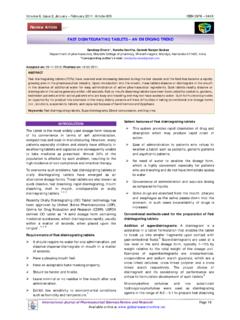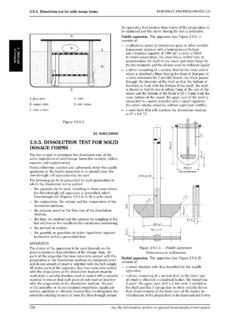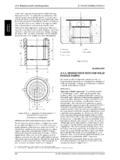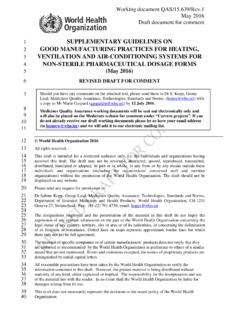Transcription of INDUSTRIAL PROCESS VALIDATION OF SOLID DOSAGE …
1 Volume 4, Issue 2, September October 2010; Article 025 ISSN 0976 044X International Journal of Pharmaceutical Sciences Review and Research Page 145 Available online at INDUSTRIAL PROCESS VALIDATION OF SOLID DOSAGE FORMS AN OVERVIEW Satyabrata Jena*, G. Arjun, N. V. Anil Kumar Ravipati, kumar, , David Banji Department of pharmaceutics, Nalanda College of pharmacy, Nalgonda, Andhra Pradesh. Pin-508 001, India. ABSTRACT VALIDATION is one of the important steps in achieving and maintaining the quality of the final product. If each step of production PROCESS is validated we can assure that the final product is of the best quality. VALIDATION of the individual steps of the processes is called the PROCESS VALIDATION . Different DOSAGE forms have different VALIDATION protocols.
2 Here this article concentrates on the PROCESS VALIDATION of SOLID DOSAGE forms, protocol preparation and regulatory basis for PROCESS VALIDATION with special emphasis on tablets in industry. It gives in detail the VALIDATION of each step of the manufacturing PROCESS through wet granulation. Keywords: PROCESS VALIDATION , SOLID DOSAGE forms, Tablets, Regulatory basis, Protocol. INTRODUCTION The principal objective of DOSAGE form design is to achieve a predictable therapeutic response to a drug included in a formulation which is capable of large scale manufacture with reproducible product quality. To ensure product quality, numerous features are required, like chemical and physical stability, suitable preservation against microbial contamination if appropriate, uniformity of dose of drug, acceptability to users including prescriber and patient, as well as suitable packing, labeling, and validation1.
3 PROCESS VALIDATION establishes the flexibility and constraints in the manufacturing PROCESS controls in the attainment of desirable attributes in the drug product while preventing undesirable properties. This is an important concept, since it serves to support the underlying definition of VALIDATION , which is a systematic approach to identifying, measuring, evaluating, documenting, and re-evaluating a series of critical steps in the manufacturing PROCESS that require control to ensure a reproducible final USFDA defined PROCESS VALIDATION as establishing documented evidence which provides high degree of assurance that a specific PROCESS will consistently produce a product meeting its pre determined specifications and quality characteristics. 5 SOLID DOSAGE forms include tablets and capsules. The manufacturing of SOLID DOSAGE forms involves extensive powder handling.
4 The powder must be blended for uniformity and converted into the DOSAGE form either through compression or encapsulation. Typical requirements include weighing, blending, mixing/granulation areas, compression/encapsulation areas, and coating areas. 2 Despite the ongoing development of more sophisticated SOLID drug delivery systems, tablets are still by far the most prevalent SOLID DOSAGE form. The emphasis will be on the practical inspectional requirement, rather than on a theoretical approach that does not reflect the practicalities (and problems) encountered when validating actual production operations. A tablet is a pharmaceutical DOSAGE form. It comprises a mixture of active substances and excipients, usually in powder form, pressed or compacted into a SOLID . The excipients can include binders, glidants (flow aids) and lubricants to ensure efficient tabletting; disintegrants to promote tablet break-up in the digestive tract; sweeteners or flavors to enhance taste; and pigments to make the tablets visually attractive.
5 A polymer coating is often applied to make the tablet smoother and easier to swallow, to control the release rate of the active ingredient, to make it more resistant to the environment (extending its shelf life), or to enhance the tablet's TYPES OF PROCESS VALIDATION : 10, 13, 15 1. Prospective PROCESS VALIDATION . Where an experimental plan called the VALIDATION protocol is executed (following completion of the qualification trials) before the PROCESS is put to commercial use. Most VALIDATION efforts require some degree of prospective experimentation in order to generate VALIDATION support data. 2. Concurrent PROCESS VALIDATION . Establishing documented evidence that the PROCESS is in a state of control during the actual implementation of the PROCESS . This is normally performed by conducting in- PROCESS testing and/or monitoring of critical operations during the manufacture of each production batch.
6 3. Retrospective PROCESS VALIDATION . Where historic data taken from the records of the completed production batches are used to provide documented evidence that the PROCESS has been in a state of control prior to the request for such evidence. Volume 4, Issue 2, September October 2010; Article 025 ISSN 0976 044X International Journal of Pharmaceutical Sciences Review and Research Page 146 Available online at THE REGULATORY BASIS FOR PROCESS VALIDATION 3, 6, 8, 9 The concept of PROCESS VALIDATION from its beginnings in the early 1970s through the regulatory aspects associated with current good manufacturing practice (cGMP) regulations and the application thereof to various analytical, quality assurance, pilot plant, production, and sterile product and SOLID DOSAGE forms considerations.
7 In the early 1990s, the concept of preapproval inspection (PAI) was born and had as one of its basic tenets the assurance that approved VALIDATION protocols and schedules were being generated and that comprehensive development, scale-up, and biobatch and commercial batch VALIDATION data were required in order to achieve a successful regulatory PAI audit. There are several important reasons for validating a product and/or PROCESS . First, manufacturers are required by law to conform to cGMP regulations. Second, good business dictates that a manufacturer avoids the possibility of rejected or recalled batches. Third, VALIDATION helps to ensure product uniformity, reproducibility, and quality. Although the original focus of VALIDATION was directed towards prescription drugs, the FDA Modernization Act of 1997 expanded the agency s authority to inspect establishments manufacturing over-the-counter (OTC) drugs to ensure compliance with cGMP.
8 Once the concept of being able to predict PROCESS performance to meet user requirements evolved, FDA regulatory officials established that there was a legal basis for requiring PROCESS VALIDATION . The ultimate legal authority is Section 501(a)(2)(B) of the FD&C Act, which states that a drug is deemed to be adulterated if the methods used in, or the facilities or controls used for, its manufacture, processing, packing, or holding do not conform to or were not operated or administrated in conformity with cGMP. The cGMP regulations for finished pharmaceuticals, 21 CFR 210 and 211, were promulgated to enforce the requirements of the act. FDA has the authority and responsibility to inspect and evaluate PROCESS VALIDATION performed by manufacturers. The cGMP regulations for validating pharmaceutical (drug) manufacturing require that drug products be produced with a high degree of assurance of meeting all the attributes they are intended to possess (21 CFR (a) and (a)).
9 STRATEGY FOR INDUSTRIAL PROCESS VALIDATION OF SOLID DOSAGE , 6 The strategy selected for PROCESS VALIDATION should be simple and straightforward. The following five points gives strategy for PROCESS VALIDATION : 1. The use of different lots of raw materials should be included. , active drug substance and major excipients. 2. Batches should be run in succession and on different days and shifts (the latter condition, if appropriate). 3. Batches should be manufactured in the equipment and facilities designated for eventual commercial production. 4. Critical PROCESS variables should be set within their operating ranges and should not exceed their upper and lower control limits during PROCESS operation. Output responses should be well within finished product specifications. 5. Failure to meet the requirements of the VALIDATION protocol with respect to PROCESS input and output control should be subjected to PROCESS requalification and subsequent revalidation following a thorough analysis of PROCESS data and formal discussion by the VALIDATION team.
10 GUIDELINES FOR PROCESS VALIDATION OF SOLID DOSAGE FORMS 3, 5 Numerous factors should be considered when developing and validating SOLID DOSAGE forms. As a means of providing a broad overview of these VALIDATION criteria, the following checklist/guideline as in Table 1, is provided for tablets and dry-filled capsules for inclusion in an in-depth VALIDATION program. Some of these unit operations will not be applicable for every SOLID DOSAGE form ( , direct compression tablets and uncoated tablets). PROTOCOL FOR PROCESS VALIDATION . The protocol for PROCESS VALIDATION is given from the tables 2, 3, 4 & 5 as follows: STEPS FOR VALIDATION AND ACCEPTANCE CRITERIA The following steps (Table 6) are used in industry for VALIDATION of tablets in wet granulation PROCESS . INDUSTRIAL PROCESS EVALUATION AND SELECTION FOR TABLETS 3, 14, 16, 18 Determine the unit operations needed to manufacture the tablets.














